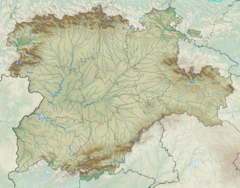Sierra de Atapuerca | |
 Atapuerca Mountains panorama | |
| Location | near Atapuerca, Ibeas de Juarros |
|---|---|
| Region | Burgos, Castile and León |
| Coordinates | 42°22′0″N 3°31′20″W / 42.36667°N 3.52222°W |
| History | |
| Periods | Paleolithic |
| Associated with | Homo antecessor, Homo heidelbergensis, Homo neanderthalensis |
| Site notes | |
| Excavation dates | since 1964 |
| Archaeologists | Francisco Jordá Cerdá |
| Website | http://www.atapuerca.org/ |
| Official name | Archaeological Site of Atapuerca |
| Criteria | Cultural: (iii)(v) |
| Reference | 989 |
| Inscription | 2000 (24th Session) |
| Area | 284.119 ha (702.07 acres) |
The Atapuerca Mountains (Spanish: Sierra de Atapuerca) is a karstic hill formation near the village of Atapuerca in the province of Burgos (autonomous community of Castile and Leon), northern Spain.
In a still ongoing excavation campaign, rich fossil deposits and stone tool assemblages have been discovered which are attributed to the earliest known hominin residents in Western Europe.[1] This "exceptional reserve of data" has been deposited during extensive Lower Paleolithic presence, as the Atapuerca Mountains served as the preferred occupation site of Homo erectus, Homo antecessor, Homo heidelbergensis and Homo neanderthalensis[2] communities. The earliest specimen so far unearthed and reliably dated confirm an age between 1.2 million and 630,000 years.
The Archaeological site of Atapuerca is a World Heritage Site. Some finds are exhibited in the nearby Museum of Human Evolution, in Burgos.
- ^ "Homo heidelbergensis: Evolutionary Tree information". Smithsonian National Museum of Natural History. Retrieved January 26, 2017.
- ^ Callaway, Ewen (2016). "Oldest ancient-human DNA details dawn of Neanderthals". Nature. 531 (7594): 286. Bibcode:2016Natur.531..296C. doi:10.1038/531286a. PMID 26983523. S2CID 4459329.


